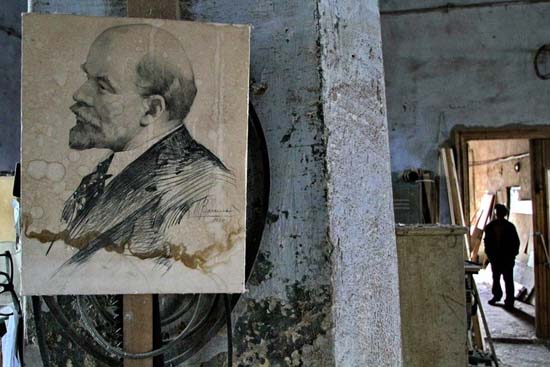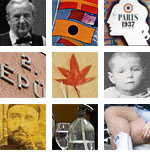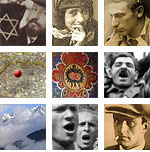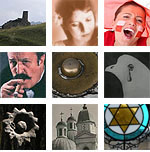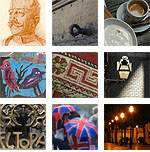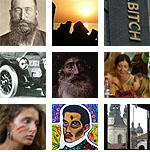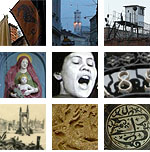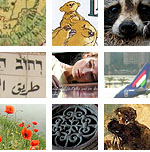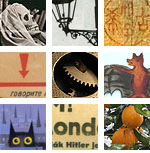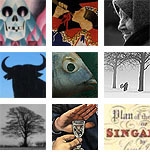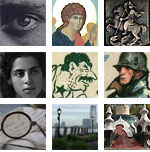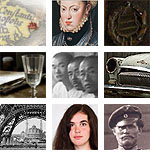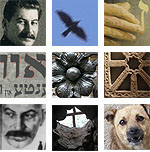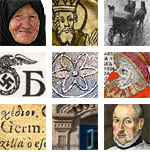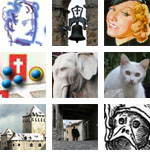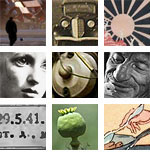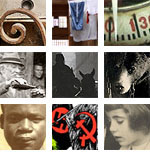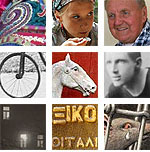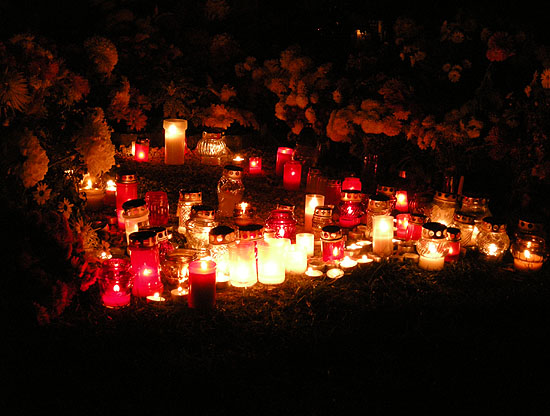



| C’erano una volta, nei palazzi e nei castelli della Grande Città, re e regine, principi e principesse, Papi e cavalieri. C’erano una volta. Ma non è di quella volta che racconta, la nostra storia. Lontano dai palazzi e dai castelli, e quasi all’insaputa dei re e delle regine, nel cuore più nascosto della Grande Città, proprio dove il fiume rallentava intorno a un’isola, là iniziava e subito aveva fine la Via dei Falegnami, una stradina talmente stretta che, affacciandosi dalla finestra di una delle sue povere abitazioni, si poteva stringere la mano di chi viveva nella casa di fronte. Era così che gli abitanti di Via dei Falegnami si passavano l’un l’altro giocattoli da scambiare, libri in prestito, vestiti da rammendare, e perfino compiti di scuola da copiare di nascosto: da finestra a finestra, allungando semplicemente una mano. Se, durante il pasto, a qualcuno di loro mancava il sale, bastava chiedere il permesso al proprio dirimpettaio, sporgersi dal davanzale senza nemmeno alzarsi dalla sedia e prendere la saliera dalla tavola del vicino cortese. | Tutti coloro che abitavano in quella strada, infine, usavano cucire sui propri abiti una stella di stoffa gialla come segno di riconoscimento, e nessuno di loro usciva mai di casa senza indossarla. Correva voce che prima o poi sarebbero giunti Giorni Terribili a strappar loro dai vestiti quei ritagli di stoffa colorata ma, per il momento, con tutte quelle stelle cucite sui panni stesi ad asciugare alle finestre dopo il bucato, la Via dei Falegnami sembrava una fitta costellazione scivolata silenziosamente giù dal cielo fin quasi a toccare il selciato. In quella via di stelle e di finestre trascorse la vita di Sara e Amos. E’ di loro che parla, questa storia. |
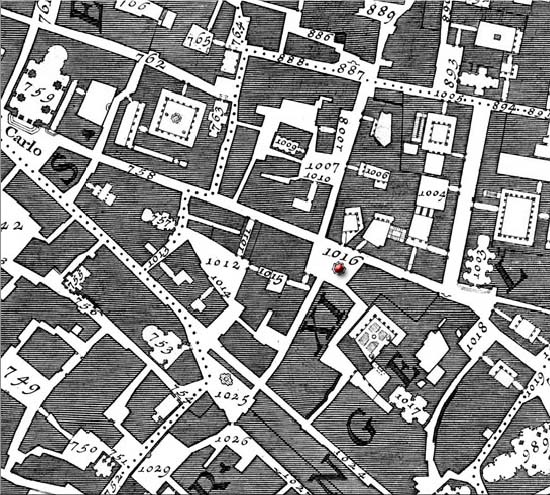
| Sara e Amos erano nati nello stesso istante nelle due case che, all’inizio di Via dei Falegnami, guardavano la Fontana delle Tartarughe. Sara era nata nella casa sul lato sinistro del vicolo, dove nascevano solo bambine, mentre Amos era nato sul lato destro della via, dove nascevano solo maschietti. I loro padri, subito dopo la nascita dei due bambini, si erano affacciati alle rispettive finestre per abbracciarsi, augurandosi a vicenda Mazal Tov, che significa Buona Fortuna. A dire il vero, e pur in mezzo a tanta felicità, qualcosa di strano era accaduto, quel giorno. La piccola Sara, nata da pochi minuti e adagiata nella culla preparata per l’occasione, pian piano aveva iniziato a levitare leggera per aria, volando lentamente verso l’alto come una piccola nuvola felice. I suoi genitori erano rimasti piuttosto sorpresi. Da quando in qua i bambini volavano? La prima a riprendersi dalla sorpresa era stata la vecchia levatrice che aveva aiutato a nascere sia Sara che tutte le altre bambine da quel lato della via. L’anziana donna aveva afferrato delicatamente la piccola per una caviglia, tirandola giù prima che andasse a battere contro il soffitto. Non vi preoccupate, aveva detto la levatrice, può capitare, a volte, per un eccesso di leggerezza, che i neonati non capiscano qual è il loro posto nel mondo, e se loro stessi siano nuvole o uccelli o persone. Basterà spiegarle quali sono le leggi di natura e vedrete che, crescendo, scorderà il volo e resterà con i piedi a terra come tutti gli altri. | La mamma di Sara aveva stretto la bimba tra le braccia, per sicurezza, e a tutti era tornato il sorriso. Contemporaneamente, nella casa di fronte, il piccolo Amos, nato anch’egli da pochi minuti, aveva iniziato a sprofondare nella culla in cui era stato adagiato, che si stava sfondando sotto il suo peso. La sua levatrice, che aveva aiutato a nascere sia Amos che tutti i bambini nati da quest’altro lato della strada, aveva afferrato il piccolo per una caviglia un attimo prima che cadesse sul pavimento attraverso il fondo ormai del tutto aperto della culla. Non vi preoccupate, aveva detto la donna ai genitori, può succedere a volte, per eccesso di pesantezza, che i neonati non sappiano qual è l’alto e quale il basso, e se loro stessi siano sassi che affondano in uno stagno, o un peso di piombo per bilance, o persone. Quando sarà cresciuto troverà il giusto mezzo, e sarà uguale a tutti gli altri. La mamma di Amos aveva adagiato il bimbo nel letto accanto a lei, sostenendolo con un braccio sotto la piccola schiena, mentre il padre rinforzava il fondo della culla con alcune assicelle di legno robusto, e tutti si sentivano felici come mai prima d’allora. |

| La Via dei Falegnami si riempì degli anni che trascorsero da quella volta in poi. Per quanto stretta e breve, la via riusciva a contenere i giorni di tutti i suoi numerosi abitanti accatastandoli ordinatamente, man mano che si accumulavano, lungo i muri di mattoni rossi delle case, sopra i davanzali e nel buio dei sottoscala. Sara e Amos erano cresciuti sani e belli, ma nessuno dei due era guarito da quelle stranezze che li facevano così diversi dagli altri bambini. Sara continuava a essere sospinta verso l’alto da una corrente verticale e lieve che la rendeva leggera come una piuma in uno sbuffo di vento, e poteva uscire di casa solo accompagnata per mano da qualcuno che le servisse da ancora per non farla volare via oltre i tetti rossi. A lei non pareva strano d’essere così come fin dalla nascita era stata, anzi, si sentiva sempre felice e sorridente. Erano gli altri abitanti della via a guardare stupiti quella bambina che non posava mai i piedi in terra. | Amos, al contrario, non poteva mai essere lasciato per troppo tempo nello stesso posto, perché allora iniziava a sprofondare nel punto esatto in cui si trovava. Occorreva che qualcuno lo afferrasse, così da tirarlo su prima che scomparisse nel pavimento o nel terreno. Quando Sara e Amos si incontrarono per la prima volta, fu naturale per loro prendersi per mano. La bimba, così leggera, rendeva leggero anche Amos che non sprofondava più e il bambino, così pesante, evitava che Sara volasse via tra le nuvole. Da quel momento, i due amici andarono in giro sempre mano nella mano, anche quando Sara, crescendo ancora, diventò così aerea che nemmeno Amos bastava più a trattenerla. L’amico allora le procurò un paio di pesanti scarpe blu con la suola di piombo. La gente della via si abituò con il tempo a vederli così: la bambina leggera, il bambino pesante, e le scarpe blu, sempre insieme. |
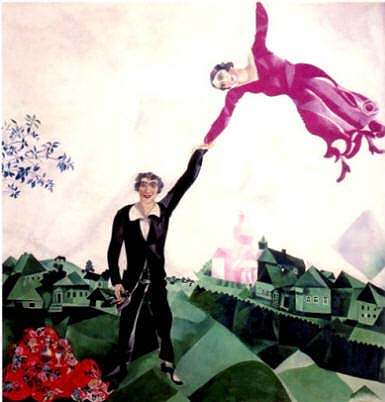
| Chissà come dev’essere, sospirò una notte Sara guardando il cielo dal suo letto. Come dev’essere cosa? chiese Amos, che l’aveva sentita dalla sua stanza nella casa dirimpetto. Volare. Volare sul serio, oltre le case, sopra le strade, su tutta la Grande Città, rispose Sara affacciandosi alla finestra. Sarebbe meraviglioso…, sospirò a sua volta Amos dal proprio davanzale. E allora facciamolo, Amos. Saliamo sui tetti, io ti insegnerò a volare e tu mi tratterrai quel tanto che basta perché il vento non ci porti via. Coraggio! Sara si arrampicò sul davanzale e, prima una e poi l’altra, si sfilò le pesanti scarpe blu, che portava anche a letto per non scivolarne fuori, e subito iniziò a veleggiare verso l’alto, tanto che Amos dalla sua finestra fece appena in tempo ad afferrarla per la mano prima che l’amica volasse via. La spinta di quel decollo li trascinò entrambi al di sopra di Via dei Falegnami, con i piedi di Amos che sfioravano appena i tetti rossi e Sara che ondeggiava leggera come fosse fatta di cielo. Com’era diverso e strano il mondo, visto da lassù! | La loro via, colma della luce gialla e densa dei lampioni a gas, dall’alto sembrava una fetta sottile di torta alla crema, tanto che veniva voglia di allungare un dito per assaggiarla, e le case ai lati del vicolo sembravano pan di Spagna morbido e dolce. Volando di tetto in tetto scoprirono che, mentre la gente dormiva, la Grande Città si popolava di strane creature, invisibili di giorno: erano i sogni notturni che uscivano dalle finestre delle stanze in cui erano stati sognati e si ritrovavano in strada per giocare a rimpiattino tra di loro e per tuffarsi allegri nel fiume che, silenzioso durante il giorno, si riempiva allora del canto di sirene dai capelli verdi, mentre le sue acque venivano solcate da galeoni di terribili filibustieri in cerca dell’isola del tesoro. Ogni notte, poi, le quattro tartarughe di pietra della fontana che si trovava all’inizio di Via dei Falegnami si animavano diventando vive, e si incamminavano per raggiungere il fiume e nuotare fino al mare, che non avevano mai visto in vita loro. Ma erano creature pesanti e lente e a metà della notte non avevano compiuto che due o tre passi appena, e allora ogni volta tornavano rassegnate alla fontana perché il giorno non le sorprendesse per strada, e da secoli si consolavano tra loro dicendo, con linguaggio e fiducia da tartarughe, Domani, ritenteremo ancora domani. Alla fine di quel primo volo, e di tutti i voli notturni che seguirono da quella volta in poi, Sara e Amos tornarono ai loro davanzali e, dopo essersi abbracciati giurando di mantenere il segreto su quello che avevano visto, si infilarono nei rispettivi letti. Ma nessuno dei due riuscì prendere sonno perché i loro occhi erano troppo colmi di felicità e stupore. |

| Dopo qualche tempo, però, gli adulti di Via dei Falegnami ripresero a dire che i Giorni Terribili sarebbero presto arrivati a portar via tutte le stelle cucite sui loro abiti. Cosa sarà di noi senza le nostre stelle? si chiese Amos. Non lo so, rispose Sara, ma tutte le volte che se ne parla in casa, papà inizia a tirarsi la barba per la disperazione, e la mamma non smette più di piangere. Deve trattarsi di qualcosa di così spaventoso che nemmeno i grandi sanno come difendersi. I giorni normali sembravano accatastarsi come sempre nella via, ma adesso con più fatica e meno ordine, come se lo spazio di colpo si fosse esaurito. La strada era ancora più corta e stretta, e quasi non ci si poteva più camminare fianco a fianco ma solo in fila indiana: quando due persone si incrociavano, una delle due doveva appiattirsi contro il muro per far passare l’altra. Alla fine, una notte la notizia arrivò: i Giorni Terribili non avrebbero tardato che poche ore appena, e quello stesso mattino sarebbero giunti in Via dei Falegnami. Nessuno riuscì a dormire, quella notte, e la strada si riempì di sospiri e di lamenti e di stelle affacciate alle finestre. Anche Sara e Amos erano svegli e si parlavano da un lato all’altro della strada, con i volti che ormai si sfioravano. Potremmo fuggire tutti lontano, propose Amos. Non servirebbe, rispose Sara. I Giorni Terribili ci troverebbero lo stesso, con questi pezzi di stoffa gialla cuciti addosso. Sono le nostre stelle che vogliono. Potessimo almeno strapparcele via noi stessi. | Perché te la prendi con le stelle? In fondo loro sono il tuo destino, disse Amos. Cosa vuoi dire? domandò Sara. Hai mai pensato a cosa succederebbe se ti togliessi le scarpe blu e io non ti trattenessi? Voleresti in alto, sempre più in alto, fino a raggiungere le stelle. Nessuno ti ritroverebbe mai, lassù. Ma certo, hai ragione! esclamò Sara. E’ questa la soluzione. Noi abbiamo imparato come si fa; lo insegneremo anche agli altri. Sara e Amos chiamarono a gran voce tutti gli abitanti della via. Chi non era già affacciato si sporse alla finestra, e tutti ascoltarono con occhi spalancati le parole dei due bambini che raccontavano di voli e pirati e tartarughe. Gli adulti erano frastornati e dubbiosi, ma non avevano altra scelta, il mattino stava per arrivare. Gli altri bambini invece pensarono che volare non doveva essere poi così difficile, visto che uccelli e mosche e farfalle lo sapevano fare senza sforzo. A un cenno di Sara e Amos, tutti salirono sui rispettivi davanzali, chi in pigiama, chi in camicia da notte, chi indossando ancora i vestiti da lavoro. E tutti, grandi e bambini, avevano la propria stella gialla cucita sull’abito. Lasciate quello che non serve, anche i brutti pensieri, spiegarono loro Sara e Amos. Dovete essere leggerissimi. E adesso, prendiamoci tutti per mano. |

| I Giorni Terribili giunsero all’alba e spalancarono furibondi le porte di ogni casa, entrarono in ogni stanza soffiando fiamme dalle narici e, con voce di tuono, chiamarono a uno a uno i nomi di tutti gli abitanti della strada. Ma nelle case, nelle stanze e nella strada ormai non c’era più nessuno, solo silenzio e vuoto. Anche le tartarughe di pietra, abbandonata la fontana, avevano finalmente raggiunto il fiume e il mare. Tutte le finestre della via erano spalancate e sopra ogni davanzale erano appaiate con cura scarpe da donna, da uomo e da bambino, abbandonate in fretta ma con ordine. Tra tutte, spiccavano con colorata felicità un paio di pesanti scarpe blu. | E ancora oggi, se nelle notti più limpide d’autunno si osserva il cielo a naso in su, è possibile vedere una fitta costellazione di stelle gialle che ruotano tutte insieme tenendosi per mano: è l’intera Via dei Falegnami che danza libera e felice il girotondo del mondo.
Flaviano Fillo, ghetto di Roma.
|

 La Via dei Falegnami è uno dei vicoli che delimitano l’area storica del Ghetto di Roma.
La Via dei Falegnami è uno dei vicoli che delimitano l’area storica del Ghetto di Roma. All’imbocco di via dei Falegnami, in Piazza Mattei, dove si trovava una porta del Ghetto (i Mattei erano una delle famiglie di gentili che aprivano e chiudevano le porte del Ghetto al tramonto e all’alba), si trova la Fontana delle Tartarughe, realizzata nel 1500 da Giacomo della Porta. Le tartarughe che le danno il nome sono successive di un secolo e attribuite al Bernini.
All’imbocco di via dei Falegnami, in Piazza Mattei, dove si trovava una porta del Ghetto (i Mattei erano una delle famiglie di gentili che aprivano e chiudevano le porte del Ghetto al tramonto e all’alba), si trova la Fontana delle Tartarughe, realizzata nel 1500 da Giacomo della Porta. Le tartarughe che le danno il nome sono successive di un secolo e attribuite al Bernini.
‘The beer was better,’ he said finally. ‘And cheaper! When I was a young man, mild beer – wallop we used to call it – was fourpence a pint. That was before the war, of course.’
‘Which war was that?’ said Winston. ‘It’s all wars,’ said the old man vaguely. |
(George Orwell, 1984, 1.8.)
|
